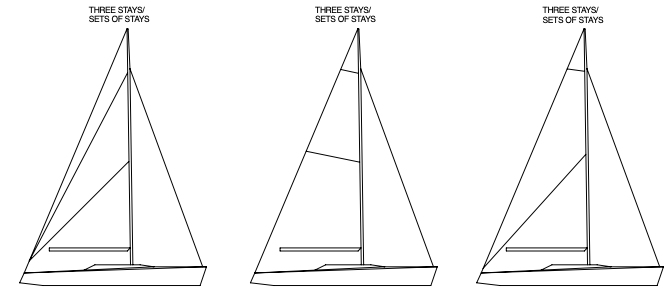IRC RULE 8 – SECONDARY RATING CERTIFICATES
 Wednesday, May 3, 2023 at 10:19AM
Wednesday, May 3, 2023 at 10:19AM  Reason for change: Owners and rule authorities request to have a second valid certificate for a separate configuration, for example inshore and offshore setup. The rule change allows a secondary certificate and specify those measurements and items that may be varied from the primary certificate. After successful trial in the southern hemisphere from August 2022 it is proposed to adopt this worldwide.
Reason for change: Owners and rule authorities request to have a second valid certificate for a separate configuration, for example inshore and offshore setup. The rule change allows a secondary certificate and specify those measurements and items that may be varied from the primary certificate. After successful trial in the southern hemisphere from August 2022 it is proposed to adopt this worldwide.
8.2.1 A boat may additionally hold a separate secondary valid certificate:
-
(a) The secondary certificate will be clearly identified and shall only vary from the
primary certificate in respect of, mainsail widths, E, P, headsail dimensions, flying headsail dimensions, single furling headsail allowance, the use of stored power, SPA, STL, SPL, spinnaker pole/bowsprit, whisker pole, number of spinnakers, number of flying headsails, aft rigging, use of moveable ballast, use of variable ballast, internal ballast;
-
(b) The secondary certificate boat weight and corresponding overhangs shall only vary from the primary certificate for a change in internal ballast. This change in boat weight is only permitted when both the primary and secondary certificates are ENDORSED in accordance with IRC Rule 8.5.
-
(c) Owners shall declare the primary or secondary certificate to the race organiser before the rating deadline.
Amend IRC Rule 22.4.2 as follows:
22.4.2 The crew weight shall not exceed 85kg multiplied by the Crew Number printed on the certificate.
2023 IRC RULE 15 and 21 – AFT RIGGING
 Wednesday, May 3, 2023 at 10:12AM
Wednesday, May 3, 2023 at 10:12AM  Reason for change: In 2017 the IRC Rules and associated code moved away from separately defining Running Backstays and Backstays into a single term of Aft Rigging. After review this is a better term to use in the rules rather than define individual components of the aft rigging.
Reason for change: In 2017 the IRC Rules and associated code moved away from separately defining Running Backstays and Backstays into a single term of Aft Rigging. After review this is a better term to use in the rules rather than define individual components of the aft rigging.
Amend IRC Rule 15 and 21.1.6 as follows:
15 MANUAL POWER
15.1 RRS 52, Manual Power, shall not apply. This Rule may be amended by Notice of Race.
15.2 (a)
The use of stored power for the hoisting of mainsails, or the reefing or furling of sail need not be declared.
-
(b) Boats using stored power solely for the adjustment or operation of backstays aft
rigging shall declare this to the Rating Authority.
-
(c) Boats using stored power for the adjustment or operation of running rigging other
than as noted in Rules 15.2(a) & (b) shall declare this to the Rating Authority.
-
(d) Boats shall not use stored power for steering unless specified by the Notice of Race.
21.1.6 (a)
Effect:
Adjustment or detachment of forestay and/or shrouds including diagonal and jumper shrouds, or movement of the mast at the foot or the deck while racing is not permitted except:
(i) in the case of a boat without running backstays, checkstays or adjustable
backstay aft rigging when the forestay may be adjusted but not detached.
Use aft rigging rather than backstay etc. in the rule.
2022 IRC RATING CHANGES
 Monday, April 25, 2022 at 10:52AM
Monday, April 25, 2022 at 10:52AM 2022
Flying Headsails
 Sunday, May 16, 2021 at 2:42PM
Sunday, May 16, 2021 at 2:42PM - Set Forward of the Forestay – either to the bow or a bowsprit
- The Half Width (FSHW) must be equal to or greater than 62.5% of foot length and less than 75% of foot length (FSFL);
- If the Half Width is less than 62.5% of foot length the sail must be rated as aheadsail. (This will increase the rating)headsail.
- If the Half Width is greater or equal to 75% of foot width the sail must be rated as aIf the Half Width is greater or equal to 75% of foot width the sail must be rated as spinnaker. (This will reduce the rating)
- No Battens
- typically these sails will be set on a furling device but this is not a mandatory requirement.
- The sail may not be set partially furled or partially reefed.

- Half Width to Foot Ratio: = FSHW/FSFL
- Minimum FSHW = FSFL * 0.625
- Maximum FSHW = FSFL * 0.749
- STLFHmax – This is calculated for a specific sail using the formula: - STLFHmax = FSFL – (0.25 * J)

